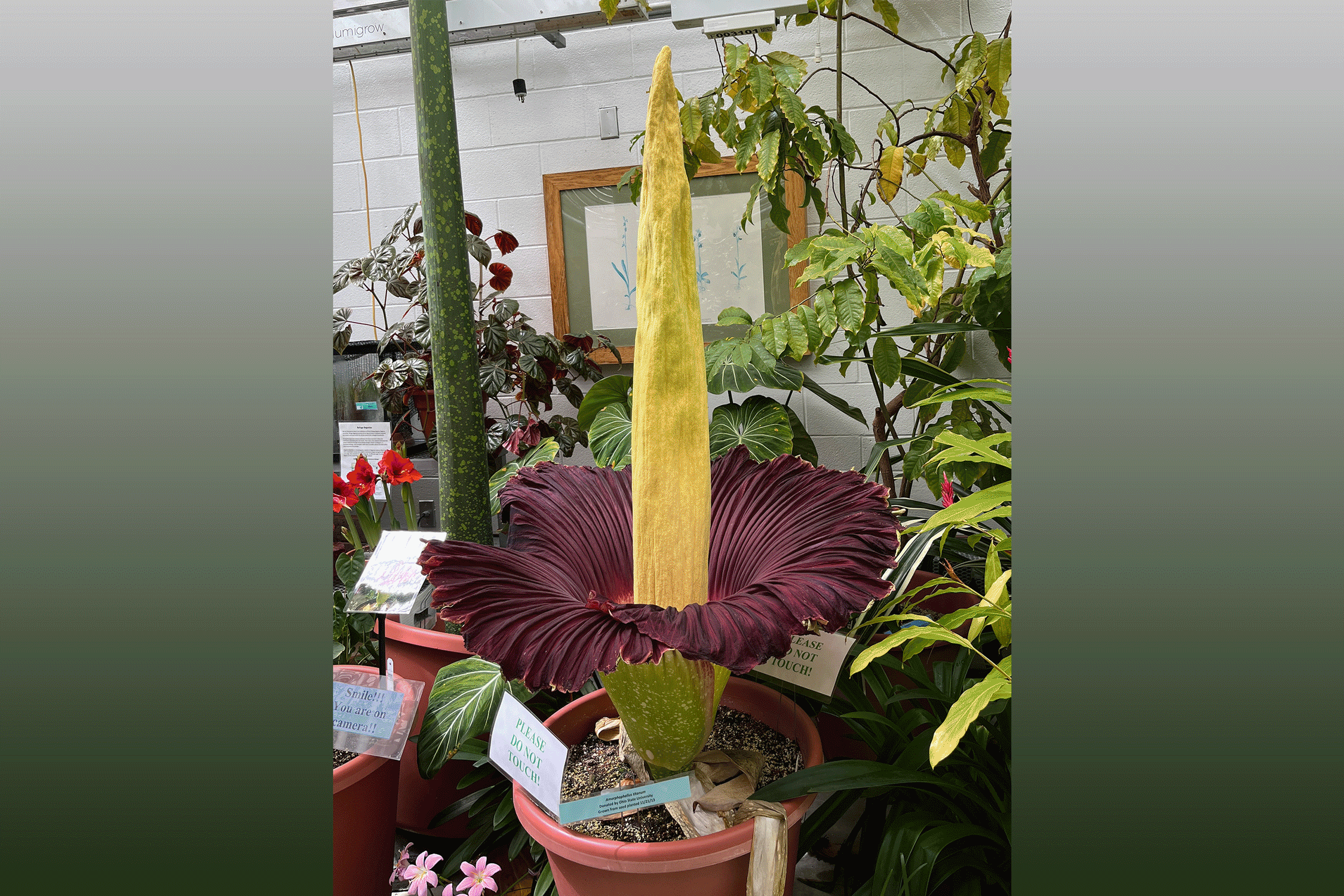The unusual odor of the titan arum, commonly called the corpse flower because its scent is reminiscent of rotting flesh, draws crowds of curious visitors to greenhouses around the world during its rare blooms. What also intrigues scientists is the corpse flower’s propensity for warming itself up just before blooming through a process known as thermogenesis, an uncommon trait in plants that is not well understood.
Now, a Dartmouth-led study looks under the hood of the corpse flower to uncover fundamental genetic pathways and biological mechanisms that drive the production of heat and odorous chemicals when the plant blooms. In their paper published Nov. 4 in PNAS Nexus, the team of scientists led by G. Eric Schaller, professor of biological sciences, also identifies a new component of the corpse flower’s odor—an organic chemical called putrescine.
Schaller, a molecular biologist who studies how plant hormones regulate their ability to grow and respond to changes in their environment, moonlights as a writer of short fiction, particularly horror fiction. “The corpse flower fits well in both these worlds,” he says.
Schaller and his collaborators took advantage of several blooms of Morphy, Dartmouth’s 21-year-old corpse flower housed in the Life Sciences Greenhouse, to collect tissue samples for genetic and chemical analysis.
The titan arum isn’t a single flower, but a cluster of small flowers hidden within a gigantic central stalk called the spadix, which can grow up to 12 feet tall and is the plant’s most striking visual feature.
The plant can go years without flowering—a 5-to-7-year interval is typical—but when it does, it blooms overnight. “The blooms are rare and also short-lived, so we only get a small window to study these phenomena,” says Schaller.
A frilly petal-like layer at the base of the spadix called the spathe unfurls to create a cup around the central stalk that is deep red or maroon on the inside. The spadix begins to heat up, rising by as much as 20 degrees Fahrenheit above the ambient temperature, followed soon after by the release of the plant’s signature scent derived from a cocktail of stinky sulfur-based compounds that attract the flies and carrion beetles that help propagate the plant.
When Morphy bloomed in 2016, the researchers gathered nine tissue samples over three nights starting when the spadix temperature peaked—from the lip and base of the spathe, and the towering spike of the spadix known as the appendix. They later added two additional leaf samples to their collection.
Alveena Zulfiqar, an exchange research scholar working in the Schaller lab at the time, figured out how to extract high-quality RNA from the tissue, enabling the team to perform RNA sequence analyses and determine the role genes play in heating up the plant and causing the odor.

“This helps us see what genes are being expressed and to see which ones are specifically active when the appendix heats up and sends out odor,” says Schaller.
Thermogenesis, or the ability to generate heat, is common in animals, but rare in plants. In animal cells, a class of proteins called uncoupling proteins interrupt the process of putting chemical energy into storage, releasing them instead as heat, Schaller says.
The RNA analysis revealed that the genes associated with the plant counterparts of these proteins, known as alternative oxidases, showed higher expression in tissues extracted when flowering began, particularly in the appendix. Also active at the time were genes involved in sulfur transport and metabolism.
To track down the mechanisms set in play by these genes, the team isolated tissues from the plant during a subsequent bloom and, working with collaborators at the University of Missouri, used a technique called mass spectrometry to identify and measure the levels of different amino acids—molecules that make up proteins—in them.
As predicted from their RNA analysis, they detected high levels of a sulfur-containing amino acid called methionine, a precursor to sulfur-based compounds known to vaporize easily upon heating, producing pungent odors. The levels of methionine dropped quickly in tissues extracted a few hours later.
What came as a surprise, says Schaller, was the detection of elevated levels of another amino acid in tissues taken from the spathe, which serves as a precursor for production of the compound, putrescine, an odorant found in dead animals when they begin to rot.
This study is the first to unravel the secrets of the corpse flower’s stink at a molecular level, determine the processes by which the titan arum regulates temperature, and identify the roles played by different parts of the flowering cluster in creating the carrion cologne that draws pollinators.
Morphy holds more mysteries, says Schaller, who is now focused on understanding the triggers that foretell flowering and whether specimens housed together might synchronize blooms to collectively raise the odor level to draw even more pollinators.

